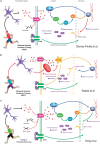The Impact of High-Intensity Interval Training on Brain Derived Neurotrophic Factor in Brain: A Mini-Review
- PMID: 30487731
- PMCID: PMC6246624
- DOI: 10.3389/fnins.2018.00839
The Impact of High-Intensity Interval Training on Brain Derived Neurotrophic Factor in Brain: A Mini-Review
Abstract
The brain-derived neurotrophic factor (BDNF) is a protein mainly synthetized in the neurons. Early evidence showed that BDNF participates in cognitive processes as measured at the hippocampus. This neurotrophin is as a reliable marker of brain function; moreover, recent studies have demonstrated that BDNF participates in physiological processes such as glucose homeostasis and lipid metabolism. The BDNF has been also studied using the exercise paradigm to determine its response to different exercise modalities; therefore, BDNF is considered a new member of the exercise-related molecules. The high-intensity interval training (HIIT) is an exercise protocol characterized by low work volume performed at a high intensity [i.e., ≥80% of maximal heart rate (HRmax)]. Recent evidence supports the contention that HIIT elicits higher fat oxidation in skeletal muscle than other forms of exercise. Similarly, HIIT is a good stimulus to increase maximal oxygen uptake (VO2max). Few studies have investigated the impact of HIIT on the BDNF response. The present work summarizes the effects of acute and long-term HIIT on BDNF.
Keywords: brain; brain-derived neurotrophic factor; health; high-intensity interval training; physical exercise.
Figures


Similar articles
-
Short-term high-Intensity interval training increases systemic brain-derived neurotrophic factor (BDNF) in healthy women.Eur J Sport Sci. 2020 May;20(4):516-524. doi: 10.1080/17461391.2019.1650120. Epub 2019 Aug 6. Eur J Sport Sci. 2020. PMID: 31386821 Clinical Trial.
-
Acute effects of two different work-to-rest ratio of high-intensity interval training on brain-derived neurotrophic factor in untrained young men.Front Physiol. 2022 Sep 7;13:988773. doi: 10.3389/fphys.2022.988773. eCollection 2022. Front Physiol. 2022. PMID: 36160866 Free PMC article.
-
Changes in exercise capacity and serum BDNF following long-term sprint interval training in well-trained cyclists.Appl Physiol Nutr Metab. 2019 May;44(5):499-506. doi: 10.1139/apnm-2018-0427. Epub 2018 Oct 4. Appl Physiol Nutr Metab. 2019. PMID: 30286300 Clinical Trial.
-
The Effect of High-Intensity Interval Training (HIIT) on Brain-Derived Neurotrophic Factor Levels (BNDF): A Systematic Review.Brain Sci. 2024 Dec 30;15(1):34. doi: 10.3390/brainsci15010034. Brain Sci. 2024. PMID: 39851402 Free PMC article. Review.
-
The Molecular Effects of BDNF Synthesis on Skeletal Muscle: A Mini-Review.Front Physiol. 2022 Jul 6;13:934714. doi: 10.3389/fphys.2022.934714. eCollection 2022. Front Physiol. 2022. PMID: 35874524 Free PMC article. Review.
Cited by
-
Influence of Secondary School Students' Physical Fitness on Sports Performance during an Ultimate Frisbee Competition.Int J Environ Res Public Health. 2022 Mar 28;19(7):3997. doi: 10.3390/ijerph19073997. Int J Environ Res Public Health. 2022. PMID: 35409680 Free PMC article.
-
Effects and Moderators of Acute Aerobic Exercise on Subsequent Interference Control: A Systematic Review and Meta-Analysis.Front Psychol. 2019 Nov 21;10:2616. doi: 10.3389/fpsyg.2019.02616. eCollection 2019. Front Psychol. 2019. PMID: 31824387 Free PMC article.
-
Changes of brain-derived neurotrophic factor (BDNF) levels after different exercise protocols: a systematic review of clinical studies in Parkinson's disease.Front Physiol. 2024 Feb 20;15:1352305. doi: 10.3389/fphys.2024.1352305. eCollection 2024. Front Physiol. 2024. PMID: 38444767 Free PMC article.
-
High-intensity training on CREB activation for improving brain health: a narrative review of possible molecular talks.Front Endocrinol (Lausanne). 2025 Jan 20;15:1498495. doi: 10.3389/fendo.2024.1498495. eCollection 2024. Front Endocrinol (Lausanne). 2025. PMID: 39902166 Free PMC article. Review.
-
Acute effects of high-intensity interval training and moderate-intensity continuous training on executive functions in healthy older adults.Sci Rep. 2025 Feb 25;15(1):6749. doi: 10.1038/s41598-025-91833-z. Sci Rep. 2025. PMID: 40000786 Free PMC article.
References
LinkOut - more resources
Full Text Sources
Medical

